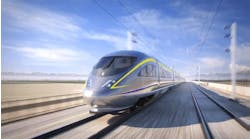NV: Heavy work on Brightline’s Vegas-to-LA project may begin soon
By Mick Akers
Source Las Vegas Review-Journal (TNS)
Brightline West is inching toward getting construction underway this year on its 218-mile Las Vegas to Southern California high-speed rail line.
Eric Scheetz, the Nevada Department of Transportation senior project manager who is overseeing the Brightline West project, said Monday that he expects shovels to hit the ground within the next few months, kicking off heavy work on the project.
But before construction can begin, NDOT is waiting on Brightline West to secure financing for the $12 billion project, as well as finalize its design and contractor deals.
Funding
Of the various project milestones hit last year, arguably the biggest was the closing of the $3 billion grant awarded to NDOT and Brightline from the Federal Railroad Administration.
“That was a huge deal for Nevada,” Scheetz said.
The rest of the $9 billion needed for the project is the responsibility of Brightline and will mainly come from private equity and debt, Scheetz said. Brightline has $5.5 billion in private activity bonding authority on the project and is on a road show seeking to sell $2.5 billion in private activity bonds, Scheetz said.
Brightline will likely foot the remaining project costs with a privately financed bank loan, Scheetz said.
“We’re watching all that and literally stuff is changing by the minute,” Scheetz said. “We’re hearing good responses from Brightline and that things are coming very close to signing on the dotted line.”
In the next month, Scheetz expects Brightline to update the financial situation, which if positive, means work on the project may begin.
“Literally in the next weeks, if not month, we will hear the information on the financing and the design-build contract negotiations,” Scheetz said. “At that point then really, heavy civil construction starts.”
Part of NDOT’s contract with Brightline includes the rail company confirming that it closed on financing, proving their capability to fund the project, before the FRA will reimburse them via the $3 billion grant.
“The nice part is, we’re not actually outlaying any state funds for that; we’re just making sure that, again, that they’ll produce what they say they will and then they are allowed to be reimbursed for that,” Scheetz said. “
Project planning
The project is expected to take about four years to complete once crews begin their work.
“It will be based off segments, but also you’ll have areas for instance where heavy civil will be completed first — lets just say approximately two to three years — and then they’ll come in and lay the rails on top of that,” Scheetz said.
NDOT will issue a right-of-way occupancy permit to Brightline West to allow them to begin work in Nevada. Part of that agreement pertains the to financing and contract negotiations of the project, as well as Brightline first finishing the design of the rail line.
Scheetz expects Brightline will complete the design sometime in the next month, for NDOT to review.
The $12 billion project is being broken up into nine segments, each one featuring separate contracts. Brightline is in the process of negotiating those contracts, Scheetz said.
“Some are more than $1 billion some are less than $1 billion, but what that does is that it brings on more capacity, more expertise to accomplish what is required,” Scheetz said. “That is basically based off geographic region and location. If there is an issue with one contractor, it’s nice to know you can bring on another contractor, to make sure everything gets finished properly.”
Managing risk
NDOT has a subrecipient agreement with Brightline, where the state basically passes all the liability of the project to Brightline, Scheetz said.
“We want to make sure Brightline stays responsible,” Scheetz said. “They are doing that and they are doing a great job of making things happen. But we have to ensure that they do complete construction of this project as we promised the FRA.”
NDOT also has an independent engineer who will keep tabs on the project on the California side to ensure everything is constructed properly.
“Managing risk is a big deal on this,” Scheetz said. “Making sure we’re in the right spot.”
Visitor driver
The Southern Nevada to Southern California line is expected to see 37 trains operating on it daily, Scheetz said.
“Lots of folks coming in from the L.A. area,” Scheetz said.
The planned Rancho Cucamonga, California, station will offer a 3,700 space parking garage for those interested in driving to the station and getting on the high-speed train. The station also will link with California’s existing passenger rail line, the Metrolink, which riders can use to travel to and from the Rancho Cucamonga station from downtown L.A., with multiple stops in between.
“That (Metrolink) connects to Southern California through different routes,” Scheetz said. “It’ll be very beneficial for getting people to that location ( Rancho Cucamonga) and ultimately to Vegas.”
©2025 Las Vegas Review-Journal.
Visit reviewjournal.com.
Distributed by Tribune Content Agency, LLC.

